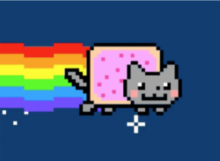NFTs are increasing in popularity, and articles about investors becoming rich from NFTs are becoming more frequent. But what is an NFT?
Put simply, NFT stands for non-fungible token. It is a digital code that represents a digital item which could be pretty much anything—music, art, memorabilia, videos, a tweet, and even virtual furniture that can be used in video games have all been sold as NFTs. The NFT exists on a blockchain—a shared, immutable ledger—which includes proof of ownership. Each token has its own unique information tied to it (metadata, to be exact) so it can never be replaced or replicated.
To be clear, NFTs are not a cryptocurrency. What makes NFT different from something like Bitcoin is that Bitcoin has the same value (in other words, it is fungible), while every NFT is worth a different value. Anything can be tokenized to become an NFT, from graphic art designs, videos, or even photos you have taken yourself.
Here’s a real-world example of the difference between an NFT and a cryptocurrency: You can exchange your $1 bill with another person’s $1 bill because they are fungible methods of payment. You would be receiving something of the same value back. However, if you have a rare $1 bill worth lots of money, exchanging it for another dollar would no longer be equal. Your rare dollar is the only one with that specific serial number on it, so therefore it would be non-fungible.
In many ways NFTs are like art
 This Nyan Cat NFT artwork by Chris Torres sold for $600,000 at the time that it was purchased. You may be thinking: it’s visible on my screen without purchasing it, so what makes it worth that much money?
This Nyan Cat NFT artwork by Chris Torres sold for $600,000 at the time that it was purchased. You may be thinking: it’s visible on my screen without purchasing it, so what makes it worth that much money?
The simple answer is the owner has original traceability, much like a serial number on a $1 bill would, which leads to social prestige.
NFTs can continue gaining value through time just as paintings and art by famous artists do. What determines that value though, is now handled digitally and automatically by smart contracts contained within a blockchain.
How to purchase an NFT
If investing in NFTs sounds like something you want to do, the first step is to visit an NFT marketplace. Most of these are hosted on Ethereum’s blockchain. Some of the biggest are OpenSea, Rarible, and CryptoSlam.
Then, you will need to have a crypto wallet to store your cryptocurrency. There are different kinds of cryptocurrency out there, and ETH, Ethereum’s native currency, is a popular one that can be used to purchase NFTs. If you’re looking to resale your NFTs, the selling options vary from platform to platform. While this just scratches the surface for how to invest, a great step by step guide to purchasing NFTs can be found here.
NFTs can be a fun and exciting investment, but keep in mind that NFT collecting comes with risks.
Buyer beware
The Better Business Bureau notes that consumers should watch for volatility, look out for fakes, and read the fine print. Buyers and sellers could be anywhere in the world. Transactions could be governed by global or regional laws that involve trade regulations, anti-money laundering and other regulations.
Learn more about the risks from the BBB.
Definitions*
Blockchain: A blockchain is basically what it sounds like; a chain of blocks. Blocks contain digital information – imagine them as packets of data all tied up, like a present.
Metadata: Put simply; metadata is data about data. More specifically, metadata summarizes key details about your data, making it easier to find and edit digital files (think titles, image tags, date created, author name, etc.).
Tokenization: Tokenization is the process of replacing sensitive data with unique identification symbols that retain all the essential information about the data without compromising its security.
*Definitions are taken from the following linked websites and go into more detail
By Meagan Brown, TDS Communications Intern


